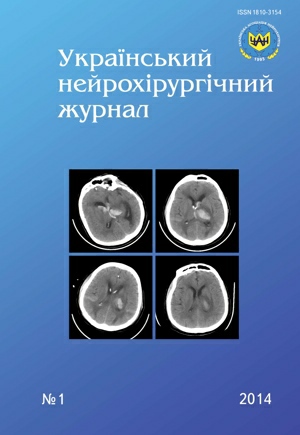A case of successful surgical treatment of thoracic spine traumatic injury with TX vertebra unstable penetrating compression-comminuted fracture
DOI:
https://doi.org/10.25305/unj.51534Keywords:
thoracic spine, compression-comminuted fracture of the vertebra, reconstructive-stabilizing surgery, plastic of spinal dura defectAbstract
Clinical case of surgical treatment of thoracic spine traumatic injury with unstable penetrating compression-comminuted fracture of TX vertebra, spinal canal and roots compression without injury of motor areas and sensitivity is given. Features of the traumatic factor were analyzed. The algorithm used, instrumental methods and operation performing are described.
To clarify the nature of thoracic spine injury without clinical signs of spinal cord lesion we used spiral computed tomography, it’s results complemented spondylography data. This allowed to detail the nature of dural sac compression, and to define features of further surgical tactics.
For posterior spine stabilization we used system of screws by Medtronic Sofamor Danec BASIS (USA), which was installed from the posterior-side approach, allowing to provide decompression of roots at damaged segment, ventral compression of dual sac by vertebra fragments was achieved by spine distraction using system for pedicle fixation. Composite adhesive DuraSeal using let us effectively eliminate defect of the spinal dura doubling into intervertebral foramen region.
References
1. Rahimi-Movaghar V, Sayyah MK, Akbari H, Khorramirouz R, Rasouli MR, Moradi-Lakeh M, Shokraneh F, Vaccaro AR.
2. Epidemiology of traumatic spinal cord injury in developing countries: a systematic review. Neuroepidemiology. 2013;41(2):65-85. [PubMed] [CrossRef]
3. Shpachenko NN, Klimovitskij VG, Stegnij SA. Osobennosti meditsinskoy pomoshchi i prognoz iskhodov pri pozvonochno-spinnomozgovoy travme na dogospital'nom etape [Care and prognosis features of spinal cord injury outcomes on prehospital phase]. In: Abstract Book of the Conference “Spine surgery – the full range” dedicated to 40 anniversary of the Department of Pathology of the Spine; 2007; Moscow , Russia. Moscow , 2007. p.336-9. Russian.
4. Polishchuk NE, Korzh NA, Fishchenko VYa. Povrezhdeniya pozvonochnika i spinnogo mozga (mekhanizmy, klinika, diagnostika, lecheniye) [Spine and spinal cord damages (the mechanisms, clinical features, diagnosis, treatment)]. Kiev: Kniga plyus; 2001. Russian.
5. Klimov VS, Shulev IuA. Kliniko-epidemiologicheskiy analiz ostroy travmy sheynogo otdela pozvonochnika i spinnogo mozga v Tul'skoy oblasti [Clinical and epidemiological analysis of acute injury of the cervical spine and spinal cord in Tula region]. Neurokhirurgia. 2008:3:68-72. Russian.
6. Akshulakov SK, Karimbaev TT. Epidemiologiya travm pozvonochnika i spinnogo mozga [Epidemiology of spine and spinal cord injuries]. In: Abstract Book of the III Congress of Russian Neurosurgeons; 2002 June 4-8; Sankt-Peterburg, Russia. Sankt-Peterburg, 2002. p.182. Russian.
7. Finn MA, Faulkner ND, Hetzel SJ, Anderson PA. Spinal duraplasty materials and hydrostasis: a biomechanical study: Laboratory investigation. J Neurosurg Spine. 2011;15(4):422–7. [PubMed] [CrossRef]
Downloads
Published
How to Cite
Issue
Section
License
Copyright (c) 2014 Volodymyr Reznichenko, Yuri Senchik, Evgen Chernysh

This work is licensed under a Creative Commons Attribution 4.0 International License.
Ukrainian Neurosurgical Journal abides by the CREATIVE COMMONS copyright rights and permissions for open access journals.
Authors, who are published in this Journal, agree to the following conditions:
1. The authors reserve the right to authorship of the work and pass the first publication right of this work to the Journal under the terms of Creative Commons Attribution License, which allows others to freely distribute the published research with the obligatory reference to the authors of the original work and the first publication of the work in this Journal.
2. The authors have the right to conclude separate supplement agreements that relate to non-exclusive work distribution in the form of which it has been published by the Journal (for example, to upload the work to the online storage of the Journal or publish it as part of a monograph), provided that the reference to the first publication of the work in this Journal is included.









